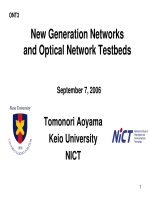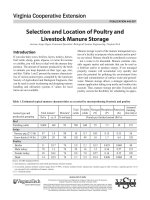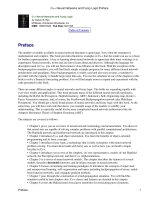Networks and location
Bạn đang xem bản rút gọn của tài liệu. Xem và tải ngay bản đầy đủ của tài liệu tại đây (1018.42 KB, 169 trang )
Networks and Location
Organizing the Diversified Multinational
Corporation for Value Creation
Anthony Goerzen
Networks and Location
This page intentionally left blank
Networks and Location:
Organizing the Diversified Multinational
Corporation for Value Creation
By Anthony Goerzen, PhD
© Anthony Goerzen 2005
All rights reserved. No reproduction, copy or transmission of this
publication may be made without written permission.
No paragraph of this publication may be reproduced, copied or
transmitted save with written permission or in accordance with
the provisions of the Copyright, Designs and Patents Act 1988, or
under the terms of any licence permitting limited copying issued
by the Copyright Licensing Agency, 90 Tottenham Court Road,
London W1T 4LP.
Any person who does any unauthorised act in relation to this
publication may be liable to criminal prosecution and civil claims
for damages.
The author has asserted his right to be identified as the author
of this work in accordance with the Copyright, Designs and
Patents Act 1988.
First published 2005 by
PALGRAVE MACMILLAN
Houndmills, Basingstoke, Hampshire RG21 6XS and
175 Fifth Avenue, New York, N. Y. 10010
Companies and representatives throughout the world
PALGRAVE MACMILLAN is the global academic imprint of the
Palgrave Macmillan division of St. Martin’s Press, LLC and of
Palgrave Macmillan Ltd.
Macmillan® is a registered trademark in the United States, United
Kingdom and other countries. Palgrave is a registered trademark in
the European Union and other countries.
ISBN-13: 978–1–4039–4766–6 hardback
ISBN-10: 1–4039–4766–2–X
hardback
This book is printed on paper suitable for recycling and made
from fully managed and sustained forest sources.
A catalogue record for this book is available from the British
Library.
Library of Congress Cataloging-in-Publication Data
Goerzen, Anthony, 1960Networks and location : organizing the diversified multinational
corporation for value creation / by Anthony Goerzen.
p. cm.
Includes bibliographical references and index.
ISBN 1–4039–4766–2–X (cloth)
1. Conglomerate corporations. 2. International business
enterprises–Location. 3. Strategic alliances (Business).
4. Diversification in industry. I. Title.
HD2756.G63 2005
338.8′8–dc22
10
14
9
13
8
12
7
11
2005047467
6
10
5
09
4
08
3
07
2
06
1
05
Printed and bound in Great Britain by
Antony Rowe Ltd, Chippenham and Eastbourne
Dedication
In a large project, such as this book and the PhD thesis that underlies
it, there are usually many people involved, aside from the author and
editor. In my case, the role of my family must be underscored given
that my wife and children had a secure and comfortable life before I
became involved in the rigours of academic life and the sacrifices they
willingly made were at the root of my ability to undertake and complete this work. In particular, my wife, Amanda, had to bear the main
burden of keeping my emotional and family life intact while I concentrated on my professional and intellectual development. Her unfailing
support for my virtually all-consuming effort to establish myself as a
researcher and teacher and her perpetual positive perspective on the
process–through the highs and especially the lows that appear to be a
commonly-experienced and inherent part of earning a doctorate–
cannot be understated. Without her, my PhD and this book would not
have been completed and probably not even attempted. While my
entry into academia has been primarily for my own personal intellectual growth, my hope is that it will benefit my entire family, not only
in tangible ways but, more importantly, by showing through example
the opportunities that can be realized through education. This book is
dedicated to my family; thank you Amanda, Frances, Adrian, and
Dana.
There are also a number of people to whom I owe both an intellectual debt and personal thanks in completing this book. First, Paul
Beamish (University of Western Ontario) played a central role in
encouraging and facilitating my entry into academia. Not only has
Paul been a key resource, he has also been an indispensable figure of
personal support. There also have been several other people that
played very important roles; three that stand out are Doug Baer
(University of Victoria), Rajulton Fernando (University of Western
Ontario), and John Hulland (University of Pittsburgh). They not only
taught me a great deal about quantitative methods but also, on many
occasions, they acted as sounding boards as I tested my ideas and
sought guidance on analytical techniques to overcome some critical
data management problems. Doug, Rajulton, and John have all repeatedly gone well beyond what could be expected of established faculty
members and they have become role models for me as I begin my own
v
vi Dedication
academic career. While there have been many others who have guided
me through important aspects of my thesis and coursework, they are
too numerous to be individually listed here; yet, the contributions of
all those who gave of their own time and expertise will be remembered
by me.
Contents
Dedication
v
List of Tables
viii
List of Figures
x
Foreword
xi
Preface
xii
Acknowledgements
xiv
A Note on the Author
xv
Chapter 1 An Expanded View of Multinational
Corporation Diversification
1
Chapter 2 Geographic Scope: The Impact of Location on
MNC Performance
9
Chapter 3 Alliance Networks: A New Dimension of
Diversification
32
Chapter 4 Product Diversity: The Traditional View of
Business Diversification
58
Chapter 5 Patterns of Multinational Corporation
Diversification
69
Chapter 6
78
Drawing the Pieces Together
Appendix 1
Research Methods
89
Appendix 2
A Note on Measuring MNC Diversification
127
Notes
131
References
133
Index
150
vii
List of Tables
Table 2.1
Table 2.2
Table 2.3
Table 3.1
Table 3.2
Table 3.3
Table 4.1
Table 4.2
Table 5.1
Table 5.2
Table 5.3
Table 5.4
Table 6.1
Table 6.2
Table A1.1
Table A1.2
Table A1.3
Table A1.4
Table A1.5
Table A1.6
Selected Studies on the Impact of Geographic
Diversity on Performance
The Effects of Geographic Scope on Economic
Performance
The Effects of International Asset Dispersion
on Dependent Manifest Variables
Selected Studies on the Performance
Implications of Network Diversity
The Effect of Alliance Network Diversity on
Economic Performance
Latent Variable Effects on Dependent Manifest
Variables
Selected Studies on the Link between Product
Diversity and Performance
The Effect of Product Diversity on MNC
Performance
A Comparison of Means Based on MNC
International Asset Dispersion
A Comparison of Means Based on MNC
Country Environment Diversity
A Comparison of Means Based on MNC
Alliance Network Diversity
A Comparison of Means Based on MNC
Product Diversity
1998 Market Growth by Geographic Region
Average Total No. of Subsidiaries versus
Percent Joint Ventures by Region
Preliminary Investigation Interview Protocol
Preliminary Investigation Firm Statistics
(FY 1999)
Preliminary Investigation Respondent
Summary
Summary of 1999 Corporate Statistics
Descriptive Statistics of Manifest Variables
Number of Missing Values per Variable
viii
10
24
25
35
47
50
63
65
70
71
73
77
83
85
91
91
92
93
100
101
List of Tables ix
Table A1.7
Table A1.8
Table A1.9
Table A1.10
Table A1.11
Table A1.12
Table A1.13
Table A1.14
Table A1.15
Table A1.16
Table A1.17
Table A1.18
Table A1.19
Table A2.1
Normal Distribution Analysis and
Transformation Statistics
Sample Outliers
Manifest Variable Correlations
Theta-Delta Matrix
Item Validity
Construct Convergent and Discriminant
Validity
Latent Variable Correlation Matrix
Item Reliability (Variance Explained)
Summary of Fit Indices on Entire Sample
Standardized Residuals
Summary of Possible Path Modification Indices
Summary of Possible Error Covariance
Modification Indices
Summary of Fit Indices on Alternative Samples
Some Measurement Approaches in Selected
Prior Studies
103
105
111
112
113
114
114
115
116
118
119
122
125
128
List of Figures
Figure 1.1
Figure 1.2
Figure 2.1
Figure 2.2
Figure 2.3
Figure 2.4
Figure 3.1
Figure 3.2
Figure 3.3
Figure 3.4
Figure 3.5
Figure 4.1
Figure 4.2
Figure 4.3
Figure 6.1
Figure A1.1
Figure A1.2
Figure A2.1
A Model of Multinational Corporation
Diversity and Economic Performance
Research Design
The Relationship between International Asset
Dispersion and MNC Performance
The Relationship between Country Environment
Diversity and MNC Performance
A Typology of MNC Geographic Configuration
The Combined Effects of Dispersion and
Diversity on MNC Performance
Japanese FDI versus Royalties/License Fees
Paid to/by Japanese Firms 1989–1999
A Transaction Cost View of Alliance Diversity
and MNC Performance
A Network Theory View of Alliance Diversity
and MNC Performance
The Effect of Alliance Network Diversity on
MNC Performance
Performance Implications of Hybrid Network
Alliance Diversity Strategies
The Marginal Benefit and Marginal Cost of
Product Diversity
The Relationship between Product Diversity
and MNC Performance
The Effect of Product Diversity on MNC
Performance
The Combination of MNC Diversity on
Corporate Performance
Frequency Chart of MNC Annual Revenue
Stemleaf Plot of Standardized Residuals
Study Type by Year of Publication
x
5
7
15
19
20
27
38
43
46
48
51
60
64
66
88
102
117
129
Foreword
I met Anthony Goerzen 20 years ago when he was an undergraduate at
Wilfrid Laurier University. He was clearly the strongest student in my
International Business elective, already exhibiting one of the key characteristics of every great scholar: a deeply-held curiosity. Before he
graduated and entered the private sector, we chatted about the possibility that he might someday wish to pursue an academic career. After
more than a decade of success in various private sector positions,
curiosity won out. Academia is the better for it.
The key ideas within his book were fashioned as part of his PhD
research. To receive a PhD requires a “contribution to our existing
body of knowledge.” Most doctoral dissertations provide modest contributions to knowledge. Some provide a major contribution to knowledge. Once in a long while, a dissertation provides multiple major
contributions. Goerzen’s book is such an example.
Anthony Goerzen looks at the combined effect of product, geographic and network diversity on multinational enterprise performance. He devises a new measure for geographic scope, one which
considers the related elements of international asset dispersion and
country environment diversity. He also introduces a new concept of
network diversity, and examines how it is strategically linked to performance. Perhaps most importantly, he is able to empirically and theoretically demonstrate that a larger, more diverse network of alliances
is not necessarily a good idea. These are important findings, with far
reaching implications for practice and theory.
Paul Beamish
London, Ontario
xi
Preface
Research on the relationship between the diversity of a firm’s activities
and its performance has a long heritage in a number of disciplines
including industrial economics, finance, organizational economics, and
strategy. In general, researchers within these disciplines have focused on
issues of primary importance to their respective fields. As a result,
studies from an industrial economics perspective have tended to emphasize the ways in which market structure influences firm diversity
and vice versa. Researchers in finance have most often examined the
impact of diversification, usually in the context of mergers and acquisitions, on common stock performance using assumptions from the
capital asset pricing model. Organizational economists have looked at
the limits to business diversity as well as the motives to diversify.
Strategy researchers have taken a more instrumental and prescriptive
approach by attempting to determine the ways in which firms can
manage diversification strategy to improve organizational performance.
The earliest studies on diversity were fairly simple tests designed to
understand the impact of diversity. By introducing and refining analytical tools to operationalize diversity, these studies laid the groundwork
for later research that became increasingly sophisticated through
improved measures and controls. Taken together, there exists a great
deal of knowledge about the conditions under which diversity matters.
Despite more than 40 years of research, however, there is no common
understanding on this important topic.
This book, therefore, addresses several gaps in our understanding by
adopting a strategic perspective on the complex phenomenon of firm
diversification, analyzing the traditional view of product diversity,
expanding the element of geographic scope into more useful subcomponents, and adding the new concept of alliance network diversity
– a new facet of diversification that has become increasingly important
to managers and strategy scholars. By examining these various aspects
of firm diversification, my intention is to provide guidance to managers of large, complex organizations. While an integrated view of firm
diversification is beyond the scope of this book, I attempt to combine
the facets of diversity to achieve a better overall understanding of MNC
management. In doing so, my second goal is to provide an impetus to
scholars to re-examine the traditional views on the organization of
xii
Preface xiii
firm activities in light of the changing demands on firms, particularly
multinational corporations, in light of economic globalization and the
trend towards expanding interorganizational networks.
Acknowledgements
I gratefully acknowledge the financial assistance of the Social Sciences
& Humanities Research Council (Grant # R1484A26). I also acknowledge John Wiley & Sons, Inc. and the Strategic Management Journal
(Professor Dan Schendel, Editor) for their copyright permission.
xiv
A Note on the Author
Prior to entering into academia, Anthony Goerzen spent almost
15 years in various sales, marketing, and general management positions in private industry. His last position before returning to graduate
study was as Vice President of Oxbow Carbon & Minerals, Inc., a multinational firm with headquarters in West Palm Beach, Florida and
annual revenues of about $US 400 million.
Dr. Goerzen earned his PhD from the Richard Ivey School of Business
at the University of Western Ontario. His thesis entitled, “Network
diversity and multinational enterprise performance,” defended in 2001,
won the Udayan Rege Best Dissertation Award 2000–2002 (a biannual PhD
thesis competition held by the Administrative Science Association of
Canada) and was selected into the final four of the Gunnar Hedlund Best
Dissertation Award 2002 (sponsored by the Institute of International
Business and the European International Business Association) as well as
the Barry Richman Best Dissertation Award 2002 (sponsored by the
Academy of Management).
Anthony Goerzen’s primary research interests centre on the strategic
management of firms competing in international markets with a focus
on the organizational and performance effects of interfirm networks,
alliances, and country risks. He has published his research in several
academic journals including Strategic Management Journal, Academy of
Management Executive, Management International Review, and The Journal
of Small Business and Entrepreneurship. In addition, he has written
several book chapters including those in Challenge and Response: North
American Firms in East Asia and The Impact of Trade Liberalization:
Communicating with APEC Communities, and The Changing Character of
Japanese Direct Investment in Canada. Further, Dr. Goerzen has presented at numerous conferences in Canada, the US, and Europe and
has received the 2002 Best Paper Award as well as the 2003 Best Reviewer
Award, both sponsored by the Academy of International Business.
Dr. Goerzen has also developed a number of cases and teaching
materials. His work can be found in several books including The
Environment of Business: International Perspectives, 2005, D. Conklin
(ed.); International Business: An Asia Pacific Perspective, 2004, A. Delios &
P. Beamish (eds); Fundamentals of International Management, 1st Edition,
2004, A. Phatak, R. Bhagat & R. Kashlak (eds); International Business: An
xv
xvi A Note on the Author
Asia Pacific Perspective, 2004, A. Delios & P. Beamish (eds); International
management, 5th Edition, 2003, P. Beamish, A. Morrison, A. Inkpen, &
P. Rosenzweig (eds); Asia-Pacific cases in strategic management, 1st
Edition, 2001, P. Beamish (ed.); Strategic Management, 6th Edition, 2001,
P. Beamish (ed.). In addition, one of his teaching cases entitled, The
Global Branding of Stella Artois, has become one of Ivey Publishing’s Top
10 Best Sellers from 2001–2005 and was also the second runner-up in
the 2001 Annual Case Competition, an annual teaching case competition held by the Academy of International Business.
1
An Expanded View of Multinational
Corporation Diversification
Business diversity1 has been studied for many years because the logic
that underpins the relatedness of a firm’s activities, and the extent
to which these activities are connected, have important practical implications (Rumelt, 1974; Wrigley, 1970). Given the accelerating trend
towards economic globalization, a process that is being driven forward
by multinational corporations, the impact of diversification of these
firms’ activities is increasingly important to managers who are responsible for their organization’s strategic direction, to strategy scholars
who are focused on the behaviour and performance of firms in the
international marketplace, and to policy-makers who must understand
the nature of the organizations that populate the economy. Yet, prior
research has not achieved a consensus on the relationship between
diversity and economic performance for reasons that relate, in part, to
inadequate or incomplete theory (Dess, Gupta, Hennart, & Hill, 1995;
Hoskisson & Hitt, 1990). This book, therefore, examines the traditional
theoretical views on the relationship between business diversity and
performance and also introduces several new concepts that have
become increasingly relevant.
First, this book examines whether the traditional element of geographic scope can and should be separated more precisely into the
related components of dispersion and diversity. Second, the role of
alliance networks is examined, an important dimension of corporate
diversity rarely considered in empirical research. Further, the analysis
was based on a sample of Japanese firms, thus responding to the frequent suggestion by various observers that we understand little about
organizations that emanate from outside Western contexts yet are
influential in shaping our economic, social, political, and cultural
milleux.
1
2 Networks and Location
Several important empirical findings evolved from this research
and will be discussed in detail in the chapters that follow. It was
found, for example, that the new concept of network diversity is an
important element in the management of MNCs. It was discovered
that firms that follow focused strategies – either through internallybased growth with sparse interorganizational networks or through
network-based growth within large and highly diverse networks –
experience superior performance. On the other hand, the firms that
implement a mix of these two approaches tend to experience inferior performance. This result provides a counterpoint to the widely
held theoretical view that a larger, more diverse network yields
benefits to the firm.
A second important finding reported in this book relates to the
impact of geographic scope on the firm. The traditional concept of geographic scope was divided into the related concepts of international
asset dispersion and country environment diversity; it was discovered that
international asset dispersion has a positive and linear relationship
with MNC performance whereas the new concept of country environment diversity has a nonlinear relationship with economic performance. MNCs benefit from country environment diversity at lower
levels but this positive effect reaches an inflection point after which
negative returns result.
These findings provide a more complete explanation of the relationship between multinationality and MNC economic performance. Yet,
readers may benefit from an initial outline of the debate on the relationship between diversity and performance that has swirled for the
last 40 years. The following section, therefore, provides a brief analysis
of previous scholarship on product, geographic, and alliance diversity
with greater detail to follow, in turn, in Chapters 2–4.
Product diversity: the traditional view of firm diversification
Diversity in a firm’s activities has most often been defined in prior
research as the number of different products offered. Based on this tradition, a large amount of research has examined the relationship
between this important dimension of diversity and various aspects of
industry and firm attributes, processes, and outcomes. It is for good
reason that researchers have used the product dimension as the sole
definition of diversity since the decision of what good or service to
provide, and for whom, is at the heart of strategic management; these
An Expanded View of Multinational Corporation Diversification 3
issues are, perhaps, the single most important set of decisions made by
senior management. In addition, in the early days of this research
stream, most organizations were devoted entirely to their domestic
markets and, as such, the dimensions of diversity that have become of
more recent interest (e.g., geographic scope) had not yet become an
important element of strategic management.
More recently, researchers have begun to question the basic
notion of relatedness, suggesting that the concept of diversity is
more complex than has been operationalized in prior research. The
primary impetus behind this movement came from researchers interested in the resource-based view of the firm who suggested that traditional measures of product relatedness provide an incomplete
picture of the scope of the firm (Markides & Williamson, 1994). For
this reason, a number of authors grappled with the underlying
concept of relatedness, attempting to drill down into the firm to
attain a more complete, firm-specific view of diversity. Farjoun
(1998), for example, examined the concept of product diversity in
terms of both physical and skill relatedness finding that, individually, both factors were insignificant but together they significantly
affected accounting results. Nguyen, Séror, & Devinney (1990) also
found that the relatedness of technologies was an important factor
in corporate performance. Arguing from the resource-based view
of the firm, Markides & Williamson (1994; 1996) and Robins &
Wiersema (1995) both suggested that the concept of diversity must
be made more complete, i.e., more reflective of the firm’s individual
situation. In the field of international business, researchers have
responded to the call for more complete measures of diversity, as
explained below.
Re-examining the concept of geographic scope: the impact of
diverse locations
Although scholars interested in MNCs have generally not examined
the underlying heterogeneity of resources as has become popular
from the resource-based perspective, they have instead added the
dimension of geographic scope to capture a fuller view of the productive assets of firms holding foreign-based operations. Research in
this stream has emanated from the perspective of internalization
theory; this view of firm expansion into foreign markets predicts
that firms that have intangible assets for which there is no viable
4 Networks and Location
arm’s length market will exploit them abroad. On this basis, it is
expected that firms would appropriate greater value from their
intangible assets as they are dispersed into foreign markets, thus
realizing superior economic performance. Over the years, researchers
have added significantly to our understanding for the reasons why
firms expand into foreign markets as well as the factors that underpin success. Yet, based on my review of the literature, significant
gaps exist as discussed in detail in Chapter 2.
In general, the international literature leaves off in much the same
place as the domestic literature – both suggest that the concept
of diversity in a firm’s activities is a complex, multidimensional
phenomenon that is not well understood as it relates to economic
erformance. Thus, one of the goals of this book is to examine in
greater detail the concept of diversity with the intention of deriving
a fuller view of its impact on firms. Moreover, an aspect of diversity
that has rarely been considered in either the theoretical or the
empirical literature within the diversification stream is that of
a firm’s interorganizational network diversity, as discussed in the
following section.
Alliance networks: expanding the concept of diversification
Despite the fact that most organizations operate in highly interconnected environments in which their performance, even survival,
often critically depend upon their linkages to other organizations
(Oliver, 1990), the impact of networks is only just now becoming the
focus of managerial attention and scholarly effort. The relevance of
network diversity (i.e., variance in partners’ cultures, nationalities,
and business backgrounds) is arguably an important factor in firm performance given that partners have been clearly established as having
an influence on the firm in a variety of ways (Bartlett, 1986; Davidson
& McFetridge, 1985) coupled with the fact that a great deal of international investment takes place via joint ventures (Beamish, Delios, &
Lecraw, 1997). Therefore, a theoretical rationale to justify the inclusion of this element of firm diversity as part of a multidimensional
approach will be developed in Chapter 3. As depicted graphically
in Figure 1.1, by combining these various aspects of corporate diversity (i.e., product, geographic, and network) the combined effect on
overall performance may be estimated, which is the overarching
intention of this book.
An Expanded View of Multinational Corporation Diversification 5
number of
joint ventures
number of
nations
country entropy
(employees)
country entropy
(revenue)
product entropy
(employees)
industry average
profitability
Network
Size
Unique Japanese
partners
Unique local
partners
International
Experience
Geographic
Diversity
Capital
Structure
product entropy
(revenue)
product entropy
(capital invested)
Industry
Profitability
average
subsidiary age
Economic
Performance
Product
Diversity
Firm
Size
Alliance
Network
Diversity
Proprietary
Assets
number of
employees
r&d
intensity
advertising
intensity
operation return
on capital
openning return
on sales
return
on assets
Market-toBook Ratio
Jensen’s
Alpha
Sharpe’s
Measure
Unique partner
industries
dept-equity
ratio
Figure 1.1 A Model of Multinational Corporation Diversity and Economic
Performance
Evaluating alliance networks and geographic scope: an empirical
approach
An ideal setting in which to examine the relationship between the
various aspects of diversity and performance is the MNC since its scope
of operations is inherently greater on several dimensions as compared
to uninational firms. Given that one of the basic attributes of an MNC
is that it has productive assets spread across nations, large MNCs are
not only exposed to geographic scope, but also opportunities to
develop a wider range of products for these far-flung markets and
to enter into working relationships with business partners rise at the
same time.
Since, in the view of many scholars (e.g., Bartlett & Ghoshal, 1989;
Kogut, 1985; Nohria & Ghoshal, 1997), the MNC is under particularly intense and increasing pressure to improve the integration and
6 Networks and Location
coordination of its complex structure to justify the higher transaction costs inherent in operating across socio-political and economic borders, the ability of the MNC to leverage the potential in its
portfolio of international assets has become a fundamental strategic
imperative. For these reasons, large MNCs are a critical test case for
the arguments put forward in this book and will be used as the
empirical setting in this research.
A commonly accepted definition of an MNC is an organization with
entities in two or more countries (Ghoshal & Westney, 1993). However, there is no consensus on what constitutes an MNC; this book,
therefore, will follow Stopford & Wells’ (1972) definition of an MNC,
which is an organization that has operations in at least six countries.
Moreover, the empirical setting is a sample of only Japanese firms, a
homogeneity in country-of-origin that inherently controls for macroeconomic factors such as regional business cycles that may have a differential effects on firms from one geographic area than another. In
fact, during the time frame from which the data were drawn, Japan’s
economy was undergoing severe difficulties – but this turbulence
would affect my sample of Japanese firms equally. The national origin
of the sample may also lead to concerns about lack of variance in
the independent variables (and therefore greater difficulty in finding
statistically significant relationships). However, among the methodological issues discussed in detail in Appendix 1 – Research Methods,
the firms in this sample exhibit significant variances among all
measured attributes.
Research design
The research to examine these issues was carried out in two stages
using different methods of data collection, within an iterative process
between prior research, field observations, and quantitative analysis
(see Figure 1.2). The multi-phased approach is consistent with the
advice of Parkhe (1993) who advocated an approach to research
where the suitability of each stage depends on what is already known
about the research question and what knowledge is sought. The
initial stages of the research program emphasize a more inductive
approach and the latter stages focus on deductive reasoning; however, there is a complementarity between inductive and deductive
reasoning and, in fact, the process must weave back and forth
between them (Bourgeois, 1979). The multi-method approach is
advocated by a variety of researchers since the complementary use of
An Expanded View of Multinational Corporation Diversification 7
diverse methods may lead to a more holistic understanding of the
research phenomenon (Jick, 1983; Wright, Lane, & Beamish, 1988).
As elaborated in detail in Appendix 1 – Research Methods, the initial
stage was through semi-structured interviews with 11 MNC senior
managers to gain insights into the practical aspects of managing corporate diversity. The second stage of analysis was through a latent variable structural equation model as well as a regression of latent variable
scores involving a cross-sectional sample of 580 very large MNCs
derived from data that were aggregated from a 1999 survey of 13,529
Japanese foreign subsidiaries.
It is important at this point to consider the meaning of economic
performance since this is a central concept in this book. It is widely
recognized that firms pursue multidimensional goals over time and
that firms can be viewed across a nexus of interests in the different
Semi-structured interviews with 11
multinational corporation senior managers
Development of hypotheses
Existing literature:
Cases and theory
Data compilation
and augmentation
Hypotheses testing through
structural equation modeling
Analysis, generalization,
and conclusions
Figure 1.2
Research Design
8 Networks and Location
markets (e.g., capital, industrial, and labour) on which they are
simultaneously dependent. While the performance of most organizations cannot be completely understood by the extent to which
they optimize a single parameter (e.g., profit, market value, growth,
market share, stability, etc.), a well-accepted assertion that relates
to firm performance is that if firms are profitable, they are selected
by the environment whereas those that are not, absent fiat, are
rejected and disappear (Fama & Jensen, 1983; Penrose, 1952). While
a few theorists believe the study of organizational performance or
effectiveness to be meaningless (e.g., Hannan & Freeman, 1977), the
mainstream view is that firms are strategic, rational actors that are
fundamentally concerned with economic results. This study, therefore, will define economic performance through both market-based
measures and accounting-based measures, as described in the detail
in Appendix 1 – Research Methods.
Organization of the book
Chapter 1 outlines the need to improve our understanding of the
impact of diversity within MNCs. Subsequent chapters are written
as stand-alone discussions to provide guidance to managers of large,
complex organizations and also to inform scholars of new empirical
results. Chapter 2 focuses directly on the concept of geographic
scope, providing an argument to refine both the measurement and
theoretical view of this construct. Chapter 3 extends our thinking on
MNC diversification to include the new element of alliance network
diversity, putting forward both a new theoretical argument as well as
a rigorous empirical test. Chapter 4 reviews received theory and
examine new empirical evidence on product diversification, the traditional view of firm diversity. Chapter 5 examines in more detail
some of the patterns that are observable within and between diversifying MNCs. Finally, Chapter 6 draws together my findings in an
attempt to integrate the traditional view to yield a broader conceptual perspective on MNC diversification. While an comprehensive
view of all theoretically important elements of firm diversification is
beyond the scope of this book, I attempt to combine both the traditional views on diversification as well as new elements of diversity
to achieve a better overall understanding of MNC management. In
the Methodological Appendix that follows these chapters, interested
readers can find a detailed description of the rigorous empirical
approach used to derived the statistical findings.









